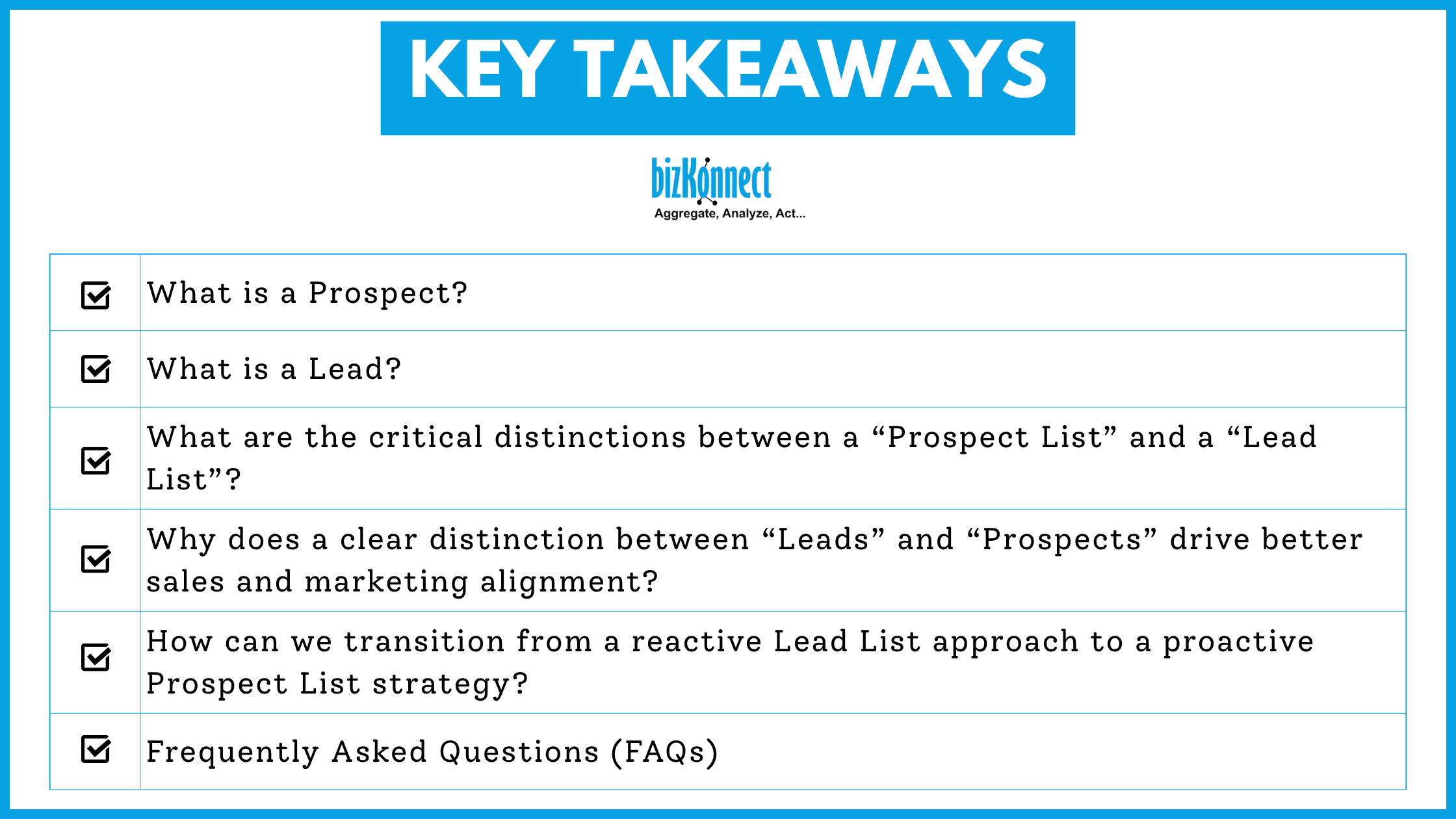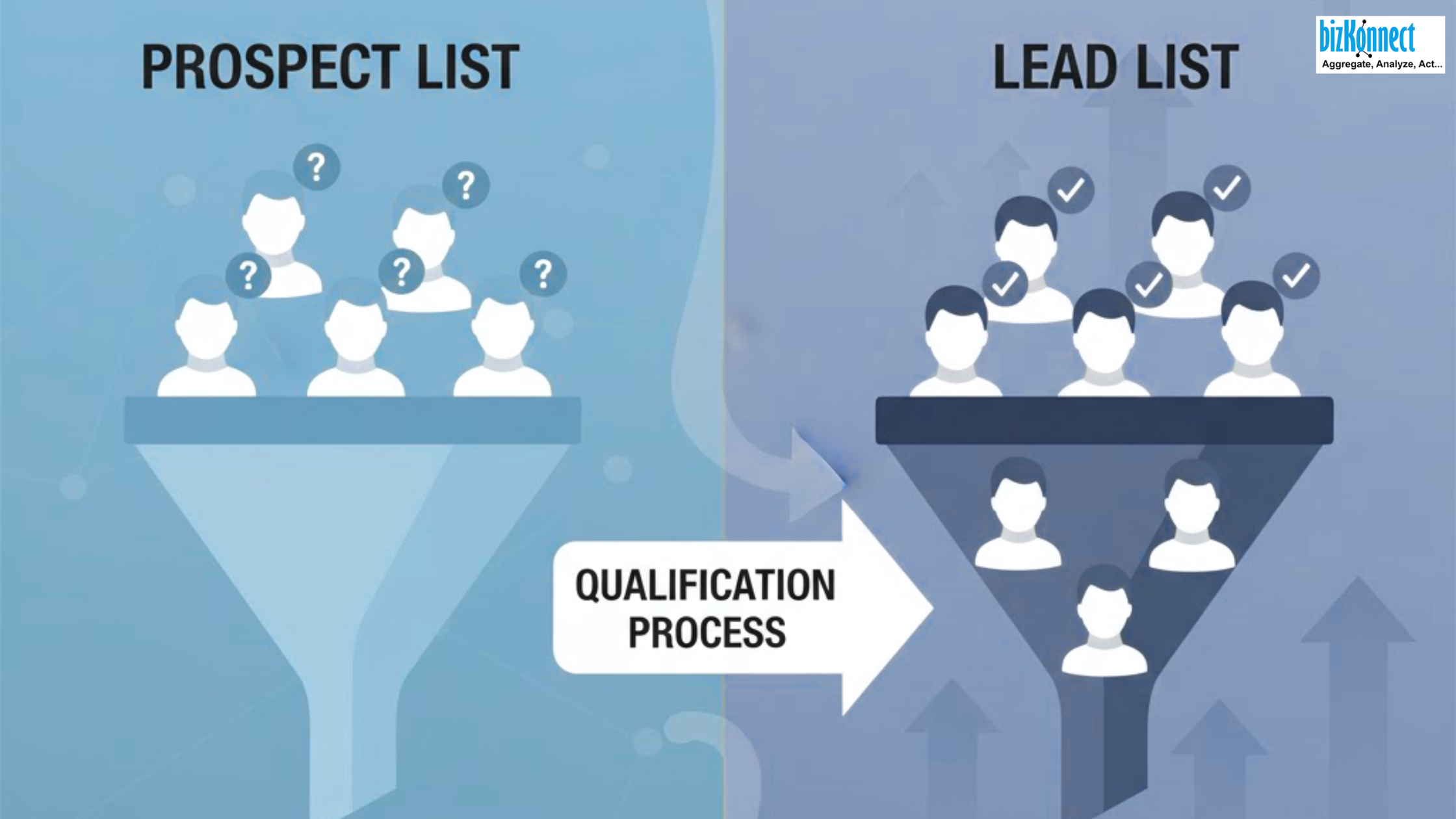B2B teams often spend weeks building lists which includes researching contacts, verifying emails, crafting sequences, and yet, conversions remain modest. Usually, the reason isn’t messaging or timing, rather it's the confusion between “prospects” and “leads”.
A prospect list and a lead list may appear similar on a paper, but they serve very different purposes.
When that distinction blurs, marketing spends its energy on the wrong audience and sales chases names that were never ready to convert. Over time, engagement rates dip, campaigns lose rhythm, and valuable opportunities are missed.

Today, this difference is more than a marketing nuance. It shapes how companies approach Account-Based Marketing (ABM), design theme-based email campaigns, and use GenAI-powered org charts to connect with decision-makers inside target accounts. The success of each of these modern techniques relies on a clear understanding of whether you’re working with prospects or leads.
Let’s understand this distinction step by step.
What is a Prospect?
A Prospect is a company or individual who has been rigorously qualified and vetted as a perfect fit for your Ideal Customer Profile (ICP). Unlike a general lead, a prospect is someone you have actively decided is a high-value, potential customer before they have necessarily engaged with your marketing materials. The transition from a simple contact to a prospect is marked by a deep understanding of their organization, challenges, industry, and the decision-makers within it.
The concept of a prospect list is central to Account Based Marketing (ABM). In an ABM strategy, you select target accounts first, based on firmographic and technographic data. And, then craft highly personalized campaigns to engage key stakeholders within those accounts. The focus shifts entirely to quality and relevance.
What is a Lead?
A lead is a person or company that has shown genuine interest in your product or service but hasn’t yet been qualified as a potential buyer. They’ve taken an action: opened an email, downloaded a whitepaper, or attended a webinar indicating awareness and curiosity.
Leads represent intent, not readiness. At this stage, the goal is to determine whether they have the budget, authority, need, and timeline to progress toward a sale. Depending on engagement level, they may be classified as Marketing Qualified Leads (MQLs) or Sales Qualified Leads (SQLs).
In practical terms, a lead is a prospect who has responded. The focus shifts from volume to validation, ensuring the right contacts are prioritized for deeper, more personalized engagement.

What are the critical distinctions between a “Prospect List” and a “Lead List”?
| Feature | Prospect List | Lead List |
| Focus | Targeted accounts and specific decision-makers | Individual contacts who showed interest |
| List Source | Proactively built based on ICP, industry research, and intent data | Reactively built from inbound forms, event sign-ups, and general campaigns |
| Sales Approach | Highly personalized outreach, theme-based email campaigns, relationship-driven | General lead nurturing, qualification process (e.g., MQL to SQL) |
Why does a clear distinction between “Leads” and “Prospects” drive better sales and marketing alignment?
The fundamental reason this distinction is so vital is that it facilitates true sales and marketing alignment by giving them a single, high-value set of accounts to pursue collaboratively.
When Marketing focuses on generating high-quality leads that fit the ICP and Sales focuses their efforts on those pre-qualified prospects, efficiency soars. In the end, they see significantly better results in new customer acquisition.
This shift away from a high-volume lead factory toward a highly targeted prospect strategy is the essence of modern B2B growth. By treating a general lead list as a source for potential prospects, and a prospect list as your immediate, high-priority target, you shorten the sales cycle and improve win rates.
How can we transition from a reactive Lead List approach to a proactive Prospect List strategy?
- Precise Prospect Identification: Start by using data-driven insights to define your ideal target companies, your initial prospect list. This foundation is crucial for any successful ABM strategy.
- Targeted Personalization: Once the prospect account is defined, the next challenge is reaching the right person with the right message. Utilizing advanced solutions like GenAI-driven org charts of target accounts, allows your team to bypass gatekeepers and directly engage the people who influence buying decisions.
- Content that Converts: General email blasts don't work for high-value prospects. An effective approach empowers you to create hyper-relevant theme-based email campaigns, tailored to the specific industry challenges and pain points of your prospect accounts. This is one of the benefits of account-based marketing for sales teams that they have better content to work with.
- Shortened Sales Cycle: By focusing on pre-qualified, high-fit prospects and engaging the right stakeholders from the start, you dramatically reduce the time it takes to move from initial contact to closed-won. When you target the right accounts with the right message, the entire process is streamlined, providing a massive competitive advantage.
Ultimately, your ABM success hinges on understanding that a Lead is a potential buyer, while a Prospect is a verified, targeted, and actively pursued future customer. Focusing on building a robust, intelligent prospect list, supported by the right technology, is the clear path to higher revenue and a truly aligned revenue engine.
Frequently Asked Questions (FAQs)
Q1. Can B2B companies succeed without maintaining both prospect and lead lists?
Not efficiently. Prospect lists build future pipelines; lead lists drive near-term revenue. Together, they sustain predictable growth.
Q2. Why is ABM important for B2B businesses?
Because ABM allows teams to focus on high-value accounts rather than broad audiences, improving personalization and sales outcomes.
Q3. How does ABM align sales and marketing teams?
Through shared data, defined target accounts, and synchronized workflows. Both teams operate with unified goals and metrics, eliminating overlap.
Q4. What are the stages of Account-Based Marketing?
Typically, they include identifying target accounts, mapping decision-makers, engaging with personalized content, measuring responses, and expanding relationships.
Your best account might be one insight away. Click here to find how BizKonnect’s data-driven ABM can help.